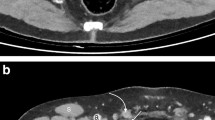Abstract
Background
The value of computed tomography (CT) for the diagnosis of clinically occult (hidden) groin hernia was assessed in a series of patients presenting with undiagnosed groin pain.
Methods
A total of 158 consecutive patients presenting over a period of 5 years with undiagnosed groin pain or lower abdominal pain and negative or equivocal clinical findings were radiologically assessed with non-contrast CT. The decision to manage operatively or conservatively was then based on a combination of the clinical and CT findings. Outcomes were assessed at 10 years follow-up.
Results
The study cohort comprised 158 patients presenting with groin or lower abdominal pain and/or swelling, and was studied prospectively. Seven of these patients were re-investigated at a later date after developing new pain on either the ipsilateral or contralateral side, giving a total of 165 CT examinations. One-third of cases (54) had clinically occult groin hernias and most of the remaining cases had diagnoses that could be managed non-operatively. Of those who came to surgery, the pre-operative CT diagnosis of hernia had a positive predictive value (PPV) of 92% and a negative predictive value (NPV) of 96% (overall accuracy 94%). Lipoma of the spermatic cord was responsible for three of five false-positive CT results. The concept of sports hernia/groin disruption injury (GDI) was encountered, and this entity is discussed in this paper. In the group of patients without hernia findings on CT, the most common diagnoses were rectus abdominis and/or pyramidalis muscle injury which could be treated by physiotherapy (22%), GDI (16%), post-surgical problems (14%), miscellaneous (20%) and ‘no abnormality’ was identified in 15%. Overall, there were 111 patients with a ‘non-hernia’ CT diagnosis, of which urological, gynaecological, gastrointestinal and neuralgia contributed to the non-musculoskeletal diagnosis.
Conclusion
This prospective non-contrast CT study of patients with undiagnosed chronic groin pain detected the majority of occult hernias requiring surgical intervention. These results suggest that CT can be a useful adjunct to the evaluation of patients presenting with chronic undiagnosed groin pain, but that experienced clinical judgment remains a critical element in the diagnostic pathway.





Similar content being viewed by others
References
Simons MP, Aufenacker T, Bay-Nielsen M et al (2009) European Hernia Society guidelines on the treatment of inguinal hernia in adult patients. Hernia 13(4):343–403
Højer AM, Rygaard H, Jess P (1997) CT in the diagnosis of abdominal wall hernias: a preliminary study. Eur Radiol 7(9):1416–1418
Smedberg SG, Broomé AE, Elmér O et al (1985) Herniography in the diagnosis of obscure groin pain. Acta Chir Scand 151(8):663–667
Ekberg O (1981) Inguinal herniography in adults: technique, normal anatomy, and diagnostic criteria for hernias. Radiology 138:31–36
Orchard JW, Read JW, Neophyton J et al (1998) Groin pain associated with ultrasound finding of inguinal canal posterior wall deficiency in Australian Rules footballers. Br J Sports Med 32:134–139
Omar IM, Zoga AC, Kavanagh EC et al (2008) Athletic pubalgia and “sports hernia”: optimal MR imaging technique and findings. Radiographics 28:1415–1438
van den Berg JC, de Valois JC, Go PM et al (1999) Detection of groin hernia with physical examination, ultrasound, and MRI compared with laparoscopic findings. Invest Radiol 34(12):739–743
van Veen RN, de Baat P, Heijboer MP et al (2007) Successful endoscopic treatment of chronic groin pain in athletes. Surg Endosc 21(2):189–193
Zarvan NP, Lee FT Jr, Yandow DR et al (1995) Abdominal hernias: CT findings. AJR Am J Roentgenol 164:1391–1395
Morales-Conde S (2009) Sportsman’s hernia: an entity to be defined, diagnosed and treated properly? Videosurg Miniinvasive Tech 4(1):32–41
Muschaweck U, Berger L (2010) Minimal Repair technique of sportsmen’s groin: an innovative open-suture repair to treat chronic inguinal pain. Hernia 14:27–33
Young J, Gilbert AI, Graham MF (2007) The use of ultrasound in the diagnosis of abdominal wall hernias. Hernia 11:347–351
Lilly MC, Arregui ME (2002) Lipomas of the cord and round ligament. Ann Surg 235(4):586–590
Gilmore OJA (1992) Gilmore’s groin—ten years experience of groin disruption. Sports Med Soft Tissue Trauma 3:12–14
Garvey JFW, Read JW, Turner A (2010) Sportsman hernia: what can we do? Hernia 14:17–25
Wollin M, Lovell G (2006) Osteitis pubis in four young football players: a case series demonstrating successful rehabilitation. Phys Ther Sport 7:153–160
Meyers WC, McKechnie A, Philippon MJ et al (2008) Experience with “sports hernia” spanning two decades. Ann Surg 248(4):656–665
Aguirre DA, Santosa AC, Casola G et al (2005) Abdominal wall hernias: imaging features, complications, and diagnostic pitfalls at multi-detector row CT. Radiographics 25:1501–1520
Miller PA, Mezwa DG, Feczko PJ et al (1995) Imaging of abdominal hernias. Radiographics 15:333–347
Acknowledgements
Dr. Michael T.W. Houang of Castlereagh Imaging, Edgecliff, Sydney, for performing the CT scans. Dr. John Read of Castlereagh Imaging, St. Leonards, Sydney, for producing the CT radiographs, reviewing the manuscript and contributing to the discussion. Mrs. Tracey Garvey (B.Appl.Sci.) who managed the data analysis. Dr. James Caristo FRACS, Surgeon, for the surgical assistance. Mr. Reinhold (Ray) Muller, Senior Lecturer (Biostatistics and Epidemiology), School of Public Health and Tropical Medicine, James Cook University, Townsville, Queensland, for the assistance in interpreting the findings and advice on quality measures. This research complies with the current laws of the Commonwealth of Australia.
Conflict of interest
There are no author disclosures.
Author information
Authors and Affiliations
Corresponding author
Rights and permissions
About this article
Cite this article
Garvey, J.F.W. Computed tomography scan diagnosis of occult groin hernia. Hernia 16, 307–314 (2012). https://doi.org/10.1007/s10029-011-0899-5
Received:
Accepted:
Published:
Issue Date:
DOI: https://doi.org/10.1007/s10029-011-0899-5




